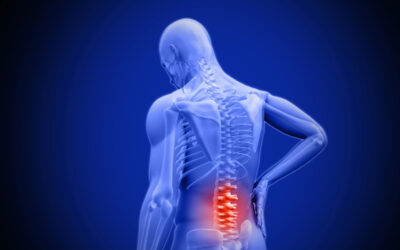
Back pain is an exceedingly common issue, affecting up to 80% of adults at some point in their lives. While most back pain resolves on its own or with self-care, certain symptoms warrant medical attention. Distinguishing between run-of-the-mill backaches and more serious conditions is crucial. This article provides guidance on recognizing when to seek professional care for back pain.
Understanding Back Pain
To understand your back pain you’ll need some knowledge of the spine to be able to pin point the issue, or at least come close to determining the source of your pain enough to communicate effectively with your doctor. Read below to understand more about your back and the source of the pain.
Definition and Types of Back Pain
Back pain is defined as soreness, tension, and discomfort originating from muscles, ligaments, discs, nerves or bones in the spine. Acute back pain comes on suddenly, often caused by trauma or injury. It typically lasts several weeks then improves. Chronic back pain persists for over 3 months, sometimes stemming from underlying conditions.
Common Causes of Back Pain
Many everyday activities can trigger back pain or exacerbate existing issues, including poor posture, repetitive motions, awkward movements, lack of exercise, muscle tension, obesity, and spinal abnormalities. Common diagnoses are muscular strain, herniated discs, spinal stenosis, arthritis, scoliosis, and sciatica. Most back pain is mechanical without an identifiable cause.
Recognizing Serious Back Pain Symptoms
While run-of-the-mill back pain often resolves on its own, certain symptoms warrant medical evaluation.
Symptoms That Warrant Medical Attention
Consult a doctor promptly for back pain that:
- Follows an injury, blow, or fall impacting the back.
- Is constant, severe, or worsens over time, especially interfering with sleep.
- Radiates into the leg(s) below the knee or down both legs.
- Is accompanied by swelling, bruising, or redness on the back.
Neurological Symptoms
Immediate medical care is advised for back pain accompanied by:
- Numbness or tingling in the leg(s) or genital area.
- Leg weakness causing difficulty standing, walking, or controlling the bladder or bowels.
- Loss of bladder or bowel control.
These neurological red flags can signify nerve compression, requiring prompt evaluation.
Risk Factors and When They Matter
Certain risk factors may influence when medical intervention is appropriate for back pain.
Age-Related Back Pain
In older adults, seemingly benign back pain may indicate serious issues like spinal fractures. Spondylolisthesis and spinal stenosis are also more common in seniors. Consultation is advised for older individuals with mild but persistent back pain.
Lifestyle and Back Pain
Lifestyle factors like obesity, smoking, sedentary work, and strenuous sports can increase susceptibility to back problems or complicate recovery. People with such risk factors may benefit from seeking medical care earlier.
Self-Care vs. Professional Care
Mild or intermittent back pain often responds well to self-care. However, some backaches require doctor’s orders.
Self-Care Measures
Gentle back exercises, OTC pain medicine, alternating cold and heat, massage, and rest can relieve many backaches. Give self-care measures 1-2 weeks to work before considering medical treatment.
Limitations of Self-Care
See a doctor if self-care fails to ease pain after 10-14 days. Also, immediately consult a physician if back pain is severe, accompanied by red flags, or impedes daily activities. Don’t delay if symptoms worsen or interfere with sleep.
The Process of Medical Evaluation
Doctors use a combination of diagnostic tools to evaluate back pain’s underlying cause.
What to Expect at the Doctor’s Office
The visit will involve discussing medical history, performing a physical exam of the back, assessing range of motion, testing reflexes, and examining posture and gait. Your doctor will check for red flags indicating a serious issue.
Potential Tests and Diagnoses
If history and exam are inconclusive, tests like x-rays, CT scans, or MRIs may be ordered to visualize the spine and identify potential structural problems. Bloodwork helps rule out infection or inflammatory arthritis. Based on results, your doctor will diagnose the back issue and recommend appropriate treatment.
Treatment Options and Follow-Up
Doctors develop a treatment plan based on the back pain diagnosis.
Non-Surgical Treatments
Mild back pain may be treated with medication, cold/heat therapy, massage, acupuncture, chiropractic adjustment, or gentle stretches and exercises. More severe cases may require steroid injections, nerve block therapies, or physical therapy.
When Surgery Might Be Necessary
If 3 months of conservative treatment fails to relieve pain and impaired function, back surgery may be an option. Procedures like discectomy, laminectomy, or spinal fusion can relieve pressure on nerves, stabilize the spine, or correct alignment. Surgery aims to reduce pain and restore flexibility.
Conclusion
Seeking timely medical care is crucial for back pain accompanied by severe or progressive symptoms. While most backaches improve with self-care, worsening pain warrants doctor’s orders. Diagnostic tests identify underlying causes, and treatments like therapy, medication, or possibly surgery, help resolve back problems. Pay attention to your body’s signals and consult a doctor when concerned. Proper back care promotes health.
Written by Dr. Tony Mork
Orthopedic Spine Surgeon
I’m Dr. Tony Mork, MD, a Minimally Invasive Orthopedic Spine Surgery Specialist in Newport Beach, California. With over 40 years of experience, I’m dedicated to providing information for all topics that involve neck and back pain.
November 9, 2023
Contact a Spine Specialist Near You!
Related Articles
Lower Back Pain | An Overview
Lower back pain is an exceedingly common affliction that affects up to 80% of adults at some point in their lives. Understanding the underlying causes of lower back pain is key to finding the appropriate treatment and relief. Anatomy of the Lower Back The lower back,...
Degenerative Disc Disease | Causes and Risk Factors
Degenerative disc disease describes age-related wear and tear to the rubbery spinal discs cushioning the vertebrae that can lead to chronic back or neck pain. While partly genetic, there are also lifestyle factors and injuries that accelerate disc degeneration over...
Upper (Thoracic) Back Pain | What is Causing My Pain?
Upper back pain is a surprisingly common affliction, affecting up to one-quarter of the adult population at some point. While not as prevalent as lower back pain, discomfort in the thoracic region still accounts for a substantial slice of musculoskeletal complaints...



